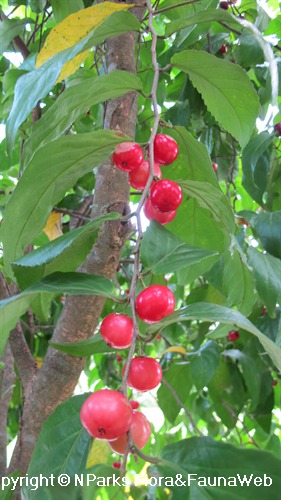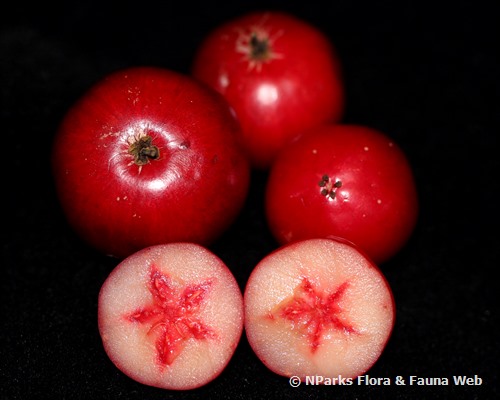
Back
Flacourtia inermis Roxb.
| Family Name: | Salicaceae |
| Common Name: | Rukam Masam, Batoko Plum, Lobi-lobi, Plum of Martinique, Thornless Rukam, Lobeh-lobeh |
Name
Classifications and Characteristics
| Plant Division | Angiosperms (Flowering Seed Plants) (Dicotyledon) |
|---|---|
| Plant Growth Form | Tree (Medium (16m-30m), Small (6m-15m)) |
| Lifespan (in Singapore) | Perennial |
| Mode of Nutrition | Autotrophic |
| Plant Shape | Oval |
| Maximum Height | 9 m to 15 m |
Biogeography
| Native Distribution | Eastern Indonesia |
|---|---|
| Native Habitat | Terrestrial (Primary Rainforest, Secondary Rainforest) |
| Preferred Climate Zone | Tropical |
| Local Conservation Status | Non-native (Spontaneous (Casual)) |
Description and Ethnobotany
| Growth Form | Small to medium-sized shrub or tree that grows to a height of 15 m. |
|---|---|
| Trunk | Bark smooth, a mixture of light brown and light grey patches. The wood is hard and either orange red or red. |
| Foliage | Leaves oval-shaped with serrate leaf margin (5 - 20 cm long, 2.5 - 9 cm wide). They have a spiral arrangement and tend to hang down from the branches. Young foliage is orange-red. |
| Flowers | Clusters of 2 - 8 small, unscented flowers (3 - 5 mm in diameter) are located near the base of leaves and along the length of twigs, but not at the ends. The flowers have greenish yellow sepals, but no petals. This species is approximately free-flowering. |
| Fruit | Fruits occur in clusters of 2 - 7 and each twig may hold more than 20 fruits. Round, shiny, cherry-like fruits (2 - 2.5 cm in diameter) are initially green, becoming red to reddish purple at maturity. Each fruit contains 4 - 14 small, stony seeds that have very sharp edges. Fruits have 4 - 5, small black-tipped projections arranged in a circle at the apex which are the remains of the styles. In Malaysia, trees bear fruits several times throughout the year with harvest most abundant during June and July. Each tree produces 40 - 100 kg fruit each year. Fruits ripen in about 3 - 5 months. |
| Others - Plant Morphology | Landscaping: Trees are planted in parks and gardens for their attractive pinkish to red young foliage. Although the fruits are also an attractive red to reddish purple, the tree's prolific production of fruits that eventually drop to the ground in large numbers is sometimes a source of complaints. Unlike some of its relatives, this species is thornless and safe for passerbys. |
| Habitat | Occurs in tropical rainforests. |
| Associated Fauna | Phalanta phalantha phalantha (Leopard butterfly), Cupha erymanthis lotis (Rustic butterfly) |
| Cultivation | This species grows best in full sun and moist, but well-drained soil. Mulch by adding organic compost or manure to the base of the tree. It grows poorly in waterlogged soils, but is able to grow on sandy soil. |
| Etymology | The genus “Flacourtia” is named after E. de Flacourt, former governor of Madagascar (1607 - 1660). The species epithet “inermis” is Latin for unarmed, referring to the absence of thorns on this plant. |
| Ethnobotanical Uses | Edible Plant Parts : Edible Fruits Food (Fruit or Vegetable): This species is sometimes grown in Puerto Rico and the Virgin Islands for its fruit. Berries have a very sour, acidic taste and are used to make pies, syrups and jellies. It is sometimes combined with Kundangan to make chutney. They are usually not consumed raw due to its sour taste. Medicinal: In traditional medicine, roots are used to prepare a poultice that is applied to wounds, sores, and sore throats. Leaf and root infusions are used to treat stomach distension. Timber & Products: In Java, the wood is used to pound rice due to the hardness of the wood. |
Landscaping Features
| Landscaping | It is suitable for planting along streetscapes, parks and gardens for its attractive young red leaves and fruits. |
|---|---|
| Desirable Plant Features | Ornamental Foliage, Ornamental Fruits |
| Landscape Uses | General, Suitable for Roadsides, Parks & Gardens |
| Thematic Landscaping | Butterfly Garden, Economic Garden, Naturalistic Garden |
Fauna, Pollination and Dispersal
| Fauna Pollination Dispersal Associated Fauna | Butterfly Host Plant (Leaves, Phalanta phalantha phalantha (Leopard butterfly), Cupha erymanthis lotis (Rustic butterfly) ) |
|---|---|
| Pollination Method(s) | Biotic (Fauna) |
| Seed or Spore Dispersal | Biotic (Fauna) |
Plant Care and Propagation
| Light Preference | Full Sun |
|---|---|
| Water Preference | Moderate Water |
| Plant Growth Rate | Moderate |
| Rootzone Tolerance | Moist Soils, Well-Drained Soils, Fertile Loamy Soils |
| Pest(s) | Chewing Insects |
| Propagation Method | Seed, Grafting, Air-Layering |
Foliar
| Foliage Retention | Evergreen |
|---|---|
| Mature Foliage Colour(s) | Green |
| Mature Foliage Texture(s) | Smooth, Glossy / Shiny, Leathery |
| Prominent Young Flush Colour(s) | Red |
| Foliar Type | Simple / Unifoliate |
| Foliar Arrangement Along Stem | Alternate |
| Foliar Attachment to Stem | Petiolate |
| Foliar Shape(s) | Non-Palm Foliage (Elliptical) |
| Foliar Venation | Pinnate / Net |
| Foliar Margin | Doubly Serrate |
| Leaf Area Index (LAI) for Green Plot Ratio | 3.0 (Tree - Intermediate Canopy) |
Non - Foliar and Storage
| Trunk Type (Non Palm) | Woody |
|---|---|
| Stem Type & Modification | Woody |
| Root Type | Underground (Tap Root, Fibrous Root) |
Floral (Angiosperm)
| Flower Colour(s) | Cream / Off-White, Green |
|---|---|
| Flower Grouping | Cluster / Inflorescence |
| Flower Location | Axillary |
| Flowering Habit | Polycarpic |
Fruit, Seed and Spore
| Mature Fruit Colour(s) | Red |
|---|---|
| Fruit Classification | Simple Fruit |
| Fruit Type | Fleshy Fruit , Non-Accessory Fruit |
Image Repository
Others
| Master ID | 1627 |
|---|---|
| Species ID | 2920 |
| Flora Disclaimer | The information in this website has been compiled from reliable sources, such as reference works on medicinal plants. It is not a substitute for medical advice or treatment and NParks does not purport to provide any medical advice. Readers should always consult his/her physician before using or consuming a plant for medicinal purposes. |


















_lowres.jpg)
_lowres.jpg)
_lowres.jpg)
_lowres.jpg)
_lowres.jpg)
_lowres.jpg)

.jpg)